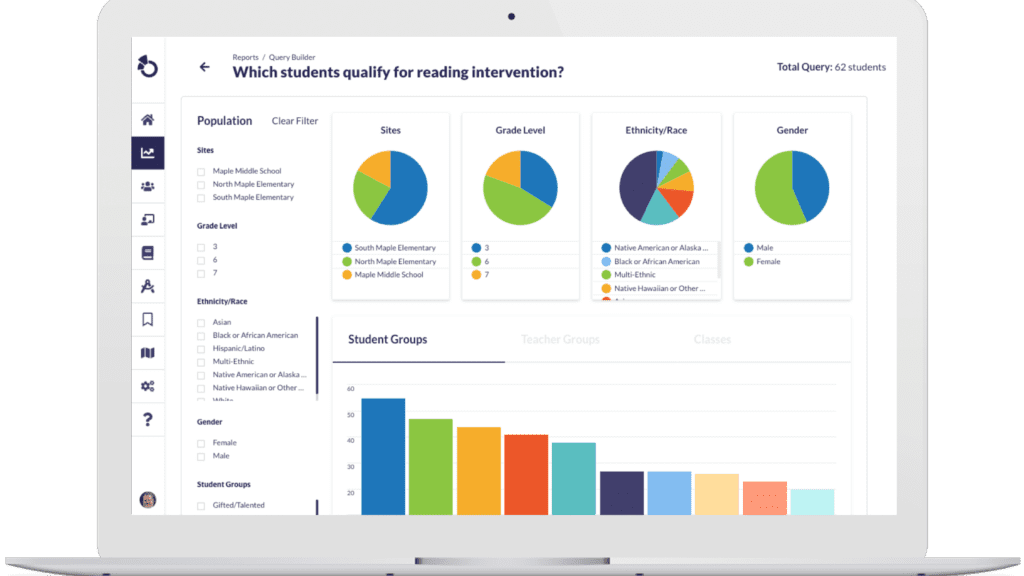8 Benefits of AI in K-12 Education & How Schools are Putting Them Into Practice
By: Otus Team
 In 2025, AI has been a part of education for years, woven into tools that teachers, administrators, and students rely on. What has changed, however, is the way schools are using AI more intentionally: to save a serious amount of time, truly personalize learning, and uncover meaningful, actionable insights that used to take days or weeks to find.
In 2025, AI has been a part of education for years, woven into tools that teachers, administrators, and students rely on. What has changed, however, is the way schools are using AI more intentionally: to save a serious amount of time, truly personalize learning, and uncover meaningful, actionable insights that used to take days or weeks to find.
Below are eight specific benefits of AI in K-12 education, organized by role. Each shows how schools are already seeing an impact, and how the right tools make those benefits practical and sustainable.
Benefits for teachers
Time saving on grading and reporting
Teachers don’t enter the profession to spend nights and weekends buried under paperwork. Yet grading, analyzing results, and building reports can easily swallow up hours each week.
Consider a high school algebra teacher with 150 students. After a quiz, AI instantly scores the work and highlights that 42% of the class is misapplying the distributive property. Instead of combing through papers line by line, the insights are just a click away, and the teacher now uses planning time to reteach that concept the very next morning.
Differentiation made doable
Every teacher wants to meet students where they are, but creating multiple versions of a lesson can feel impossible when time is limited.
Take a seventh-grade ELA teacher assigning an article on climate change. Her class spans Lexile levels from 550 to 1050. In the past, she would have had to create multiple versions of the same text at different levels, either by rewriting it herself or hunting for alternatives online. With AI, she generates three versions in minutes, assigns them to the appropriate groups, and all students can participate in the same class discussion at a level that works for them.
Real-time feedback that fuels growth
Feedback is most powerful when it’s immediate. But when students wait days to learn if they understood a concept, misconceptions set in.
Picture a fourth-grader working through a math problem. Instead of just getting a red X, AI feedback explains: “You multiplied before adding. Try reworking step by step.” The student makes the correction on the spot and builds confidence.
Benefits for students and families
Access to scalable tutoring and support
Tutoring is one of the most effective interventions, but not every student has access to a one-on-one tutor after school.
Imagine a tenth-grader stuck on geometry proofs at 9 PM. An AI-powered tutor guides them step by step, adjusting based on where they got lost. Parents log into their school’s assessment platform the next day and see a summary: “Practiced triangle congruence proofs; needs extra help on CPCTC.”
Unified data that actually tells a story
For years, educators have been buried under spreadsheets and PDFs: MAP Growth reports in the mail, state testing files shared in drives, and behavior data stored somewhere else entirely. AI changes that by bringing all those pieces together in one place.
Think about a fifth-grade teacher preparing for conferences. Instead of spending hours hunting down scores, she opens her data and insights platform and instantly sees reading, math, and SEL data side by side. She asks the AI assistant, “What’s one area this student can work on at home?” and receives tailored suggestions to share with families.
Benefits for school and district leaders
Spotting early warning signs
By the time end-of-quarter reports arrive, it’s often too late to intervene for struggling students. AI makes it possible to spot issues much sooner.
A principal logs into their data and insights platform and sees that 15 ninth graders have already missed three or more days of school this month, and their reading scores are slipping. Instead of waiting until the report cards come out, the school counselor meets with those students immediately to develop a plan.
Equity in focus
District leaders often know achievement gaps exist but struggle to pinpoint where they start and how to close them. AI helps surface those insights clearly.
For example, a district report shows that English learners’ math scores have been steadily declining for three years. Leaders can then reallocate resources, provide targeted professional development, and track whether those supports improve outcomes over time.
Stronger PLC conversations
Professional learning communities (PLCs) are meant to focus on improving instruction, but too often, most of the time is spent gathering and organizing data. Sound familiar?
In a sixth-grade math PLC, AI-generated reports show that across three classrooms, dividing fractions is the most consistent struggle. Instead of debating which standards to reteach, the team immediately plans a common lesson and forms intervention groups. The time is spent solving problems, not finding them.
Making AI work for schools
AI will never replace educators. Its job is to support teachers, their students, and school leaders with better information and more time to focus on what matters most. And with the right tools, those benefits move from theory to practice, turning AI into something schools can actually use to drive growth.
Of course, no conversation about AI is complete without considering privacy, transparency, and ethics. We cover that in detail in our guide on responsible AI in schools.
Related Resources
Request a demo!
See exactly how Otus can help your school accelerate student growth and improve student outcomes – all while saving educators time.






